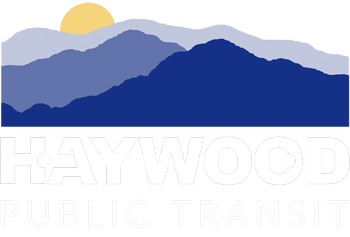Haywood Public Transit’s Mission Statement
Haywood Public Transit’s (HPT) mission is to provide safe, reliable, and expert transportation to its service area. All services provided by Haywood Public Transit will be accessible without discrimination to handicapped individuals. HPT drivers are trained and ready to assist all passengers as needed.
Haywood Public Transit Goals:
Service is provided in a manner that meets these goals to:
• provide individual, dignified services to all persons including individuals with disabilities
• expedite the safe and efficient boarding, securing, transporting and alighting of all passengers, regardless of mobility status
• accommodate the wide range of mobility aids within the confines of available vehicles and commercial standard equipment
• minimize potential damage to mobility aids and transit system equipment in the process
Haywood Public Transit’s Services: Drivers are trained to effectively assist clients using crutches, canes, walkers, braces and artificial limbs. Those clients who are blind or visually impaired may be escorted or lead onto transit vehicles. Drivers are trained to use various tools when transporting deaf or hearing impaired passengers.
Mobility Devices: HPT will provide service to all individuals using mobility devices that fit within the capacity of the lift being operated. Passengers are advised that drivers are not permitted to operate a scooter or electric wheelchair onto the lift. The passenger is responsible for getting onto the lift with minimal driver assistance for these devices or by the assistance of a caregiver. Use of the securement system on HPT vehicles will be a required condition of service. All wheelchairs and mobility devices must be secured before transport. A passenger who cannot enter the vehicle using the stairs or ramp, but who does not use a wheelchair, will be allowed to enter the vehicle using the lift. HPT does not provide wheelchairs or other mobility devices.
Accommodating Other Mobility Devices, Life Support Equipment or Service Animals: HPT will permit the use of a lift for Segway/Scooter or other personal transportation devices when used as a mobility device by eligible clients as long as it does not exceed the capacity of the lift utilized including the user, per 49 CFR §38.
Service Animals: Transit passengers will be permitted to travel with service animals trained to assist them.



